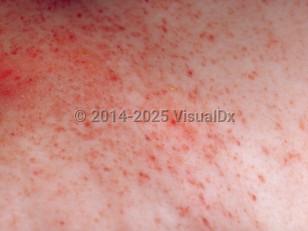Langerhans cell histiocytosis in Adult
See also in: AnogenitalAlerts and Notices
Important News & Links
Synopsis

Langerhans cell histiocytosis (LCH) is a rare histiocytic neoplastic disorder in which dendritic histiocytes accumulate in one or many organs. Activating MAPK pathway mutations, especially in BRAF V600E and MAP2K1, have been shown to be present in the overwhelming majority of patients.
LCH occurs most commonly in White male children aged 1-4 years. Studies in the United States have shown an increased incidence among individuals of Hispanic descent and a decreased incidence among Black children. LCH is rarer in adults than children.
LCH is clinically heterogeneous and classified based on the number of organ systems involved (ie, single-system or multisystem LCH). The 4 previously designated clinical variants (Letterer-Siwe disease, Hand-Schüller-Christian syndrome, self-healing reticulohistiocytosis of Hashimoto-Pritzker [congenital self-healing histiocytosis], and eosinophilic granuloma) have largely been abandoned in recent years due to significant overlap between the clinical entities and lack of prognostic relevance.
LCH can affect any organ of the body, including bones, skin, oral mucosa, genital mucosa, nail, bone marrow, lungs, liver, spleen, gastrointestinal tract, lymph nodes, and the central nervous system. The skin is affected in approximately 33% of LCH cases. The brain, spleen, bone marrow, and liver are considered high-risk organs. Involvement of one or more of these organs is associated with a higher risk of dying from the disease.
Although the lung was previously considered a high-risk organ, lung involvement is now known to be a rare cause of death. Most patients with lung involvement have a history of tobacco smoking. The lung is the most frequent organ involved in solitary cases of LCH in adults.
Skull (calvarium) lesions are considered to be a risk factor for central nervous system involvement. These patients may have a higher risk of developing diabetes insipidus and/or neurodegenerative complications. The presence of one or more BRAF mutations is positively correlated with the risk of developing neurodegenerative disease.
Additional disease sequelae can present up to decades after diagnosis, including endocrine (diabetes insipidus, growth delay), skeletal (scoliosis, abnormal dental development, hearing dysfunction), neuropsychological (cerebellar ataxia, learning disabilities), pulmonary, and hepatic involvement (sclerosing cholangitis).
LCH has an unpredictable course and may recur after resolution. LCH has also been associated with the development of leukemias and lymphomas.
LCH occurs most commonly in White male children aged 1-4 years. Studies in the United States have shown an increased incidence among individuals of Hispanic descent and a decreased incidence among Black children. LCH is rarer in adults than children.
LCH is clinically heterogeneous and classified based on the number of organ systems involved (ie, single-system or multisystem LCH). The 4 previously designated clinical variants (Letterer-Siwe disease, Hand-Schüller-Christian syndrome, self-healing reticulohistiocytosis of Hashimoto-Pritzker [congenital self-healing histiocytosis], and eosinophilic granuloma) have largely been abandoned in recent years due to significant overlap between the clinical entities and lack of prognostic relevance.
LCH can affect any organ of the body, including bones, skin, oral mucosa, genital mucosa, nail, bone marrow, lungs, liver, spleen, gastrointestinal tract, lymph nodes, and the central nervous system. The skin is affected in approximately 33% of LCH cases. The brain, spleen, bone marrow, and liver are considered high-risk organs. Involvement of one or more of these organs is associated with a higher risk of dying from the disease.
Although the lung was previously considered a high-risk organ, lung involvement is now known to be a rare cause of death. Most patients with lung involvement have a history of tobacco smoking. The lung is the most frequent organ involved in solitary cases of LCH in adults.
Skull (calvarium) lesions are considered to be a risk factor for central nervous system involvement. These patients may have a higher risk of developing diabetes insipidus and/or neurodegenerative complications. The presence of one or more BRAF mutations is positively correlated with the risk of developing neurodegenerative disease.
Additional disease sequelae can present up to decades after diagnosis, including endocrine (diabetes insipidus, growth delay), skeletal (scoliosis, abnormal dental development, hearing dysfunction), neuropsychological (cerebellar ataxia, learning disabilities), pulmonary, and hepatic involvement (sclerosing cholangitis).
LCH has an unpredictable course and may recur after resolution. LCH has also been associated with the development of leukemias and lymphomas.
Codes
ICD10CM:
C96.5 – Multifocal and unisystemic Langerhans-cell histiocytosis
C96.6 – Unifocal Langerhans-cell histiocytosis
SNOMEDCT:
65399007 – Langerhans cell histiocytosis
C96.5 – Multifocal and unisystemic Langerhans-cell histiocytosis
C96.6 – Unifocal Langerhans-cell histiocytosis
SNOMEDCT:
65399007 – Langerhans cell histiocytosis
Look For
Subscription Required
Diagnostic Pearls
Subscription Required
Differential Diagnosis & Pitfalls

To perform a comparison, select diagnoses from the classic differential
Subscription Required
Best Tests
Subscription Required
Management Pearls
Subscription Required
Therapy
Subscription Required
References
Subscription Required
Last Reviewed:02/05/2024
Last Updated:08/29/2024
Last Updated:08/29/2024
Langerhans cell histiocytosis in Adult
See also in: Anogenital
